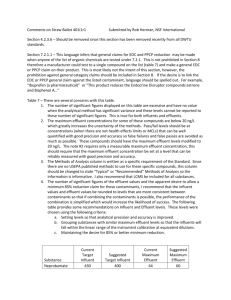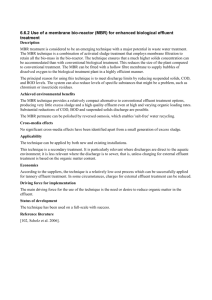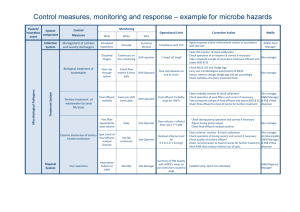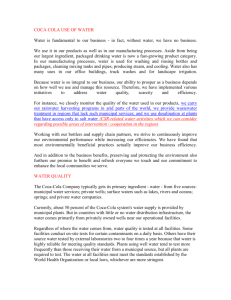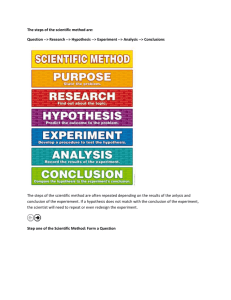STUDIES ON BIODIVERSITY AND DISEASE
advertisement
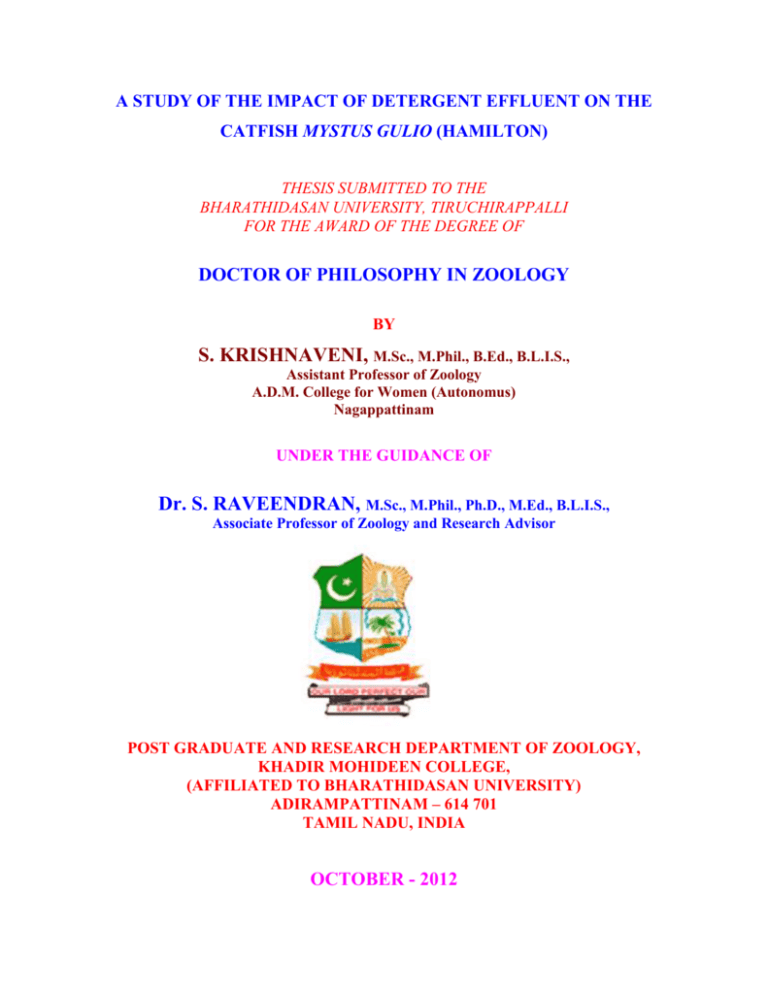
A STUDY OF THE IMPACT OF DETERGENT EFFLUENT ON THE CATFISH MYSTUS GULIO (HAMILTON) THESIS SUBMITTED TO THE BHARATHIDASAN UNIVERSITY, TIRUCHIRAPPALLI FOR THE AWARD OF THE DEGREE OF DOCTOR OF PHILOSOPHY IN ZOOLOGY BY S. KRISHNAVENI, M.Sc., M.Phil., B.Ed., B.L.I.S., Assistant Professor of Zoology A.D.M. College for Women (Autonomus) Nagappattinam UNDER THE GUIDANCE OF Dr. S. RAVEENDRAN, M.Sc., M.Phil., Ph.D., M.Ed., B.L.I.S., Associate Professor of Zoology and Research Advisor POST GRADUATE AND RESEARCH DEPARTMENT OF ZOOLOGY, KHADIR MOHIDEEN COLLEGE, (AFFILIATED TO BHARATHIDASAN UNIVERSITY) ADIRAMPATTINAM – 614 701 TAMIL NADU, INDIA OCTOBER - 2012 Dr. S. RAVEENDRAN M.Sc., M.Phil., Ph.D., M.Ed., B.L.I.S., Office : 04373-242236 Associate Professor of Zoology, Resi : 04373-235585 P.G. and Research Department of Zoology, Mobile : 9443617904 Khadir Mohideen College, Email: drsr_kmc@rediffmail.com Adirampattinam – 614 701. CERTIFICATE This is to certify that the thesis entitled “A STUDY OF THE IMPACT OF DETERGENT EFFLUENT ON THE CATFISH MYSTUS GULIO (HAMILTON)” submitted to Bharathidasan University, Tiruchirappalli by S. KRISHNAVENI in partial fulfillment of the requirements for the degree of DOCTOR OF PHILOSOPHY IN ZOOLOGY, is a record of research work done by her during the period of study under my guidance and supervision. I further certify that the thesis has not previously formed the basis for the award of any degree, diploma, associateship, fellowship or other similar title. Research Guide and Supervisor Station : Adirampattinam Date : DECLARATION I do hereby declare that this work has been originally carried out by me under the guidance and supervision of Dr. S. RAVEENDRAN, M.Sc., M.Phil., Ph.D., M.Ed., B.L.I.S., Associate Professor of Zoology, P.G. and Research Department of Zoology, Khadir Mohideen College, Adirampattinam, and that this work has not been submitted elsewhere for any other degree. (S. KRISHNAVENI) Station: Adirampattinam Date : ACKNOWLEDGEMENT I would like to express my heartfelt indebtedness and warm regards to my research mentor Dr. S. Raveendran, M.Sc., M.Phil., Ph.D., M.Ed., B.L.I.S., Associate Professor of Zoology, P.G. and Research Department of Zoology, Khadir Mohideen College, Adirampattinam, for suggesting the problem, continuous encouragement, able guidance at every stage of my work and also for introducing me to this enlightening field of research and started me on the path that led to this Ph.D. Thesis. I express my respectful and sincerest gratitude to Dr. A. Mohamed Abdul Kader, Principal, Khadir Mohideen College, Adirampattinam for the facilities provided to complete the work I am grateful to Dr. P. Kumarasamy, Associate Professor & Head, P.G. and Research Department of Zoology, Khadir Mohideen College, Adirampattinam, for his encouragement and valuable suggestions. I am highly indebted to Dr. A. Amsath, Associate Professor of Zoology, Dr. Muthukumaravel, Dr. O.Sathick, Mrs. V. Ganapriya, Dr. A. Maharajan and. Dr. J. Sukumaran Assistant Professors of Zoology, P.G. and Research Department of Zoology, Khadir Mohideen College, Adirampattinam, for their valuable suggestions and help in finishing the thesis. I have great pleasure in expressing my sincere thanks to Dr. G. Sridharan, M.Sc., M.Phil., Ph.D., Associate Professor, P.G. and Research Department of Zoology, Rajah Serfoji Government College (Autonomous), Thanjavur, for providing me all the necessary help to complete my this work. I am immensely grateful to Dr. V. Ramamurthy, M.Sc., M.Phil., Ph.D., M.L.T., Assistant Professors of Biochemistry, Marudupandiyar College, Thanjavur, for his valuable guidance and suggestions through out the tenure of this work. I acknowledge his kind help and constant encouragement with a deep sense of gratitude. I would like to express my special thanks to The Secretary and Members of Management of A.D.M College for women (Autonomous), Nagappattinam, for their advice and encouragement throughout the course of my research work and providing official permission given to constant support be extended during the course of my research work My respect and appreciation go to Dr. Mrs. A. Sivakamasundari, Principal, A.D.M College for women (Autonomous), Nagappattinam, for her guidance, continual support and advice throughout my study. I am thankful to Dr. Mrs. V. Valarmathi, Head, Department of Zoology, A.D.M College for women (Autonomous), Nagappattinam for her valuable suggestions and guidance to conduct and complete the research work. I would like to thank Dr. V. Renuga, Controller of Examinations A.D.M College for women (Autonomous), Nagappattinam, for her encouragement and constant support during the course of my research work. It is indeed a pleasure to acknowledge the timely help extended by our colleague of Biochemistry and Zoology departmental faculty members who have generously spared their precious time and made their contributions to this work. I shall be failing in my duty, if I do not acknowledge the moral support of my family members. This work would not have been possible without the enthusiasm, support and encouragement of my nephew J. Yoheshwaran, who has extended enthusiastically is worthy to be mentioned here to make this acknowledgement complete I thank to Mr. P. Muruganantham, Murugan Binding Works, Pattukkottai, for his neet typing and binding for this project work successfully. There are times when words are inadequate to express the profound sense of gratitude and appreciation one feels in the heart. “Praises can be had only from a grateful heart”. I grant my grateful appreciation and thanks to all those who have directly and indirectly contributed to this work. (S. KRISHNAVENI) LIST OF TABLES Table 1. Characteristics of detergent effluent Table 2. Biochemical characteristics of isolated bacteria Table 3. Bacterial flora from detergent effluent Table 4. Fungal flora from detergent effluent Table 5. Cyanobacterial flora from detergent effluent Table 6. Effect of different concentration of detergent effluent on mortality percentage of M. gulio during 24, 48, 72, 96 Hrs. of exposure Table 7. Effect of detergent effluent on surfacing behaviour of Mystus gulio Table 8. Effect of detergent effluent on Opercular beats of Mystus gulio Table 9. Effect of detergent effluent on rate of oxygen consumption of Mystus gulio Table 10.Haematological parameters of Mystus gulio exposure to sublethal concentration of detergent effluent after 10 days Table 11.Haematological parameters of Mystus gulio exposure to sublethal concentration of detergent effluent after 20 days Table 12.Haematological parameters of Mystus gulio exposure to sublethal concentration of detergent effluent after 30 days Table 13. Total protein content in the muscles and liver of Mystus gulio exposed to detergent effluent Table 14. Glycogen content in the muscles and liver of Mystus gulio exposed to detergent effluent. Table 15. Amino acids content in the muscles and liver of Mystus gulio exposed to detergent effluent Table 16. Lipid content in the muscle and liver of Mystus gulio exposed to detergent effluent Table 17. Levels of LDH activity in the muscles and liver of Mystus gulio exposed to detergent effluent Table 18. Levels of SDH activity in the muscles and liver of Mystus gulio exposed to detergent effluent Table 19. GOT content in the muscles and liver of Mystus gulio exposed to detergent effluent Table 20. GPT content in the muscles and liver of Mystus gulio exposed to detergent effluent Table 21. ALP content in the muscles and liver of Mystus gulio exposed to detergent effluent Table 22. ACP content in the muscles and liver of Mystus gulio exposed to detergent effluent Table 23. Phosphatase and protease content in the tissues of Mystus gulio exposed to detergent effluent LIST OF FIGURES Fig. 1. Experimental animal Mystus gulio Fig. 2. A natural habitation of Mystus gulio Fig. 3. Section in the gill of a control fish of Mystus gulio (Staining Haematoxylin / Eosin Magnification 320 X) Fig. 4. Section in the gill of 0.2% of detergent effluent treated fish of Mystus gulio (Staining Haematoxylin / Eosin Magnification 320 X) Fig. 5. Section in the gill of 0.4% of detergent effluent treated fish of Mystus gulio (Staining Haematoxylin / Eosin Magnification 320 X) Fig. 6. Section in the gill of 0.6% of detergent effluent treated fish of Mystus gulio (Staining Haematoxylin / Eosin Magnification 320 X) Fig. 7. Section in the gill of 0.8% of detergent effluent treated fish of Mystus gulio (Staining Haematoxylin / Eosin Magnification 320 X) Fig. 8. Section in the liver of a control fish of Mystus gulio (Staining Haematoxylin/ Eosin Magnification 320 X) Fig. 9. Section in the liver of 0.2% of detergent effluent treated fish of Mystus gulio (Staining Haematoxylin / Eosin Magnification 320 X) Fig. 10. Section in the liver of 0.4% of detergent effluent treated fish of Mystus gulio (Staining Haematoxylin / Eosin Magnification 320 X) Fig. 11. Section in the liver of 0.6% of detergent effluent treated fish of Mystus gulio (Staining Haematoxylin / Eosin Magnification 320 X) Fig. 12. Section in the liver of 0.8% of detergent effluent treated fish of Mystus gulio (Staining Haematoxylin / Eosin Magnification 320 X) Fig. 13. Section in the kidney of a control fish of Mystus gulio (Staining Haematoxylin / Eosin Magnification 320 X) Fig. 14. Section in the kidney of 0.2% of detergent effluent treated fish of Mystus gulio (Staining Haematoxylin / Eosin Magnification 320 X) Fig. 15. Section in the kidney of 0.4% of detergent effluent treated fish of Mystus gulio (Staining Haematoxylin / Eosin Magnification 320 X) Fig. 16. Section in the kidney of 0.6% of detergent effluent treated fish of Mystus gulio (Staining Haematoxylin / Eosin Magnification 320 X) Fig. 17. Section in the kidney of 0.8% of detergent effluent treated fish of Mystus gulio (Staining Haematoxylin / Eosin Magnification 320 X) Fig. 18. Section in the intestine of a control fish of Mystus gulio (Staining Haematoxylin / Eosin Magnification 320 X) Fig. 19. Section in the intestine of 0.2% of detergent effluent treated fish of Mystus gulio (Staining Haematoxylin / Eosin Magnification 320 X) Fig. 20. Section in the intestine of 0.4% of detergent effluent treated fish of Mystus gulio (Staining Haematoxylin / Eosin Magnification 320 X) Fig. 21. Section in the intestine of 0.6% of detergent effluent treated fish of Mystus gulio (Staining Haematoxylin / Eosin Magnification 320 X) Fig. 22. Section in the intestine of 0.8% of detergent effluent treated fish of Mystus gulio (Staining Haematoxylin / Eosin Magnification 320 X) Fig. 23. Bar diagram showing the temperature of detergent effluent Fig. 24. Bar diagram showing the pH of detergent effluent Fig. 25. Bar diagram showing the total suspended solids of detergent effluent Fig. 26. Bar diagram showing the total dissolved solids of detergent effluent Fig. 27. Bar diagram showing the free carbon dioxide of detergent effluent Fig. 28. Bar diagram showing the carbonate of detergent effluent Fig. 29. Bar diagram showing the bicarbonate of detergent effluent Fig. 30. Bar diagram showing the BOD of detergent effluent Fig. 31. Bar diagram showing the COD of detergent effluent Fig. 32. Bar diagram showing the Dissolved oxygen of detergent effluent Fig. 33. Bar diagram showing the Nitrate of detergent effluent Fig. 34. Bar diagram showing the Nitrite of detergent effluent Fig. 35. Bar diagram showing the Ammonia of detergent effluent Fig. 36. Bar diagram showing the total phosphate of detergent effluent Fig. 37. Bar diagram showing the inorganic phosphate of detergent effluent Fig. 38. Bar diagram showing the organic phosphate of detergent effluent Fig. 39. Bar diagram showing the calcium of detergent effluent Fig. 40. Bar diagram showing the magnesium of detergent effluent Fig. 41. Bar diagram showing the chloride of detergent effluent Fig. 42. Bar diagram showing the sublethal effects of detergent effluent on the number of visits of M.gulio Fig. 43. Bar diagram showing the sublethal effects of detergent effluent on the opercular beats of M.gulio Fig. 44. Bar diagram showing the sublethal effects of detergent effluent on the Oxygen consumption of M.gulio Fig. 45. Bar diagram showing the RBC number changes in M.gulio with the effects of detergent effluent exposed to different days and different concentrations Fig. 46. Bar diagram showing the WBC number changes in M.gulio with the effects of detergent effluent exposed to different days and different concentrations Fig. 47. Bar diagram showing the Hb changes in M.gulio with the effects of detergent effluent exposed to different days and different concentrations Fig. 48. Bar diagram showing the PCV changes in M.gulio with the effects of detergent effluent exposed to different days and different concentrations Fig. 49. Bar diagram showing the MCV changes in M.gulio with the effects of detergent effluent exposed to different days and different concentrations Fig. 50. Bar diagram showing the MCH changes in M.gulio with the effects of detergent effluent exposed to different days and different concentrations Fig. 51. Bar diagram showing the MCHC changes in M.gulio with the effects of detergent effluent exposed to different days and different concentrations Fig. 52. Bar diagram showing the protein content of muscles in M.gulio with the effects of detergent effluent exposed to different days and different concentrations Fig. 53. Bar diagram showing the protein content of liver in M.gulio with the effects of detergent effluent exposed to different days and different concentrations Fig. 54. Bar diagram showing the glycogen content of muscles in M.gulio with the effects of detergent effluent exposed to different days and different concentrations Fig. 55. Bar diagram showing the glycogen content of liver in M.gulio with the effects of detergent effluent exposed to different days and different concentrations Fig. 56. Bar diagram showing the amino acids content of muscles in M.gulio with the effects of detergent effluent exposed to different days and different concentrations Fig. 57. Bar diagram showing the amino acids content of liver in M.gulio with the effects of detergent effluent exposed to different days and different concentrations Fig. 58. Bar diagram showing the lipid content of muscles in M.gulio with the effects of detergent effluent exposed to different days and different concentrations Fig. 59. Bar diagram showing the lipid content of liver in M.gulio with the effects of detergent effluent exposed to different days and different concentrations Fig. 60. Bar diagram showing the LDH activity of muscles in M.gulio with the effects of detergent effluent exposed to different days and different concentrations Fig. 61. Bar diagram showing the LDH activity of liver in M.gulio with the effects of detergent effluent exposed to different days and different concentrations Fig. 62. Bar diagram showing the SDH activity of muscles in M.gulio with the effects of detergent effluent exposed to different days and different concentrations Fig. 63. Bar diagram showing the SDH activity of liver in M.gulio with the effects of detergent effluent exposed to different days and different concentrations Fig. 64. Bar diagram showing the GOT activity of muscles in M.gulio with the effects of detergent effluent exposed to different days and different concentrations Fig. 65. Bar diagram showing the GOT activity of liver in M.gulio with the effects of detergent effluent exposed to different days and different concentrations Fig. 66. Bar diagram showing the GPT activity of muscles in M.gulio with the effects of detergent effluent exposed to different days and different concentrations Fig. 67. Bar diagram showing the GPT activity of liver in M.gulio with the effects of detergent effluent exposed to different days and different concentrations Fig. 68. Bar diagram showing the ALP activity of muscles in M.gulio with the effects of detergent effluent exposed to different days and different concentrations Fig. 69. Bar diagram showing the ALP activity of liver in M.gulio with the effects of detergent effluent exposed to different days and different concentrations Fig. 70. Bar diagram showing the ACP activity of muscles in M.gulio with the effects of detergent effluent exposed to different days and different concentrations Fig. 71. Bar diagram showing the ACP activity of liver in M.gulio with the effects of detergent effluent exposed to different days and different concentrations Fig. 72. Bar diagram showing the phosphatase activity of tissues in M.gulio with the effects of detergent effluent exposed to different days and different concentrations Fig. 73. Bar diagram showing the protease activity of tissues in M.gulio with the effects of detergent effluent exposed to different days and different concentrations CONTENTS CHAPTER TITLES PAGE NO INTRODUCTION 1 Objectives of the Study 21 2 REVIEW OF LITERATURE 23 3 MATERIALS AND 51 1 1.1 METHODS Experimental Animal 51 3.1.1 Collections and maintenance of fish 51 3.1.2 Experimental setup 51 Effluents 52 3.2.2 Methods of effluent analysis 52 3.2.3 Biodiversity of microbes 53 3.2.4 Survival Studies 56 3.2.5 Experimental condition 57 Behaviour Studies 57 3.3.1 Recording of surfacing behaviour 57 3.4 Respiratory Behaviour Studies 57 3.4.1 Recording of opercular movements 57 3.4.2 Rate of Oxygen consumption 58 Heamotological Studies 58 Erythrocytes 58 3.1 3.2 3.3 3.5 3.5.1 3.5.2 Total Leucocytes 59 3.5.3 Haemoglobin content 59 3.5.4 Packed Cell Volume (PCV) 59 3.6 Biochemical Analysis 60 3.6.1 Estimation of proteins 60 3.6.2 Quantitative Estimation of Glycogen 62 3.6.3 Estimation of free Amino acids 63 3.6.4 Estimation of Lipids 63 Enzyme Assays 64 3.7.1 Determination of the Activity of GPT 64 3.7.2 Determination of the Activity of GOT 65 3.7.3 Estimation of Alkaline Phosphatase 66 3.7.4 Estimation of Acid Phosphatase 67 3.7.5 Estimation of Phosphatase 68 3.7.6 Estimation of Protease 69 3.7.7 Lactate Dehydrogenase activity 70 3.7.8 Succinate Dehydrogenase activity 70 Histology - Paraffin methods 71 3.7 3.9 4 72 RESULTS 4.1 Physico-chemical characteristics of 72 detergent effluent 4.2 Biodiversity of microbes in effluent 72 4.2.1 Bacteria 72 4.2.2 Fungi 73 4.2.3 Cyanobacteria 73 4.3 Effects of detergent effluent on Fish 74 4.4 Behaviour changes of Mytus gulio 75 4.4.1 Swimming activity 75 4.4.2 Surfacing activity 75 4.5 Respiratory behaviour 76 4.5.1 Opercular movements 76 4.5.2 Rate of oxygen consumption 76 4.6 Haematological parameters 77 4.6.1 10th day – exposure 77 4.6.2 20th day – exposure 78 4.6.3 30th day – exposure 78 Biochemical Studies of Mystus gulio 79 4.7.1 Total protein content in muscle 79 4.7.2 Total protein content in Liver 79 4.7.3 Glycogen content in muscle 80 4.7.4 Glycogen content in liver 80 4.7.5 Free amino acids in muscle 81 4.7.6 Free amino acids in Liver 81 4.7.7 Lipid content in muscle 82 4.7.8 Lipid content in liver 82 Enzymes Activities of Mystus gulio 82 4.8.1 LDH Activity in muscles 82 4.8.2 LDH Activity in Liver 83 4.8.3 SDH Activity in muscles 83 4.8.4 SDH Activity in Liver 84 4.8.5 GOT and GPT activity 84 4.8.6 Alkaline phosphatase activity 85 4.8.7 Acid phosphatase activity 86 4.8.8 Phosphatase Activity 87 4.8.9 Protease Activity 87 Histopathlogical Studies 87 4.9.1 Histology of Gills 87 4.9.2 Histology of Liver 89 4.9.3 Histology of Kidney 90 4.9.4 Histology of Intestine 91 4.7 4.8 4.9 5 147 DISCUSSION 5.1 Physico-chemical characteristics of 147 detergent effluent 5.2 Biodiversity of microbes 151 5.3 Survival studies of Mystus gulio 155 5.4 Behaviour Studies of Mystus gulio 157 5.5 Haematological Studies of Mystus gulio 162 5.6 Biochemical Studies of Mystus gulio 165 5.7 Enzymes Studies of Mystus gulio 175 5.8 Histological studies of Mystus gulio 185 6 SUMMARY 199 7 REFERENCES 207 APPENDIX

